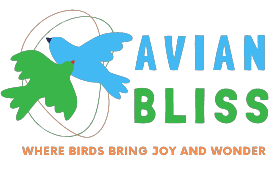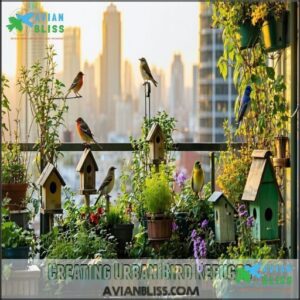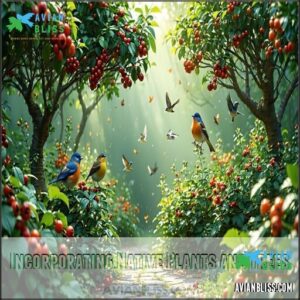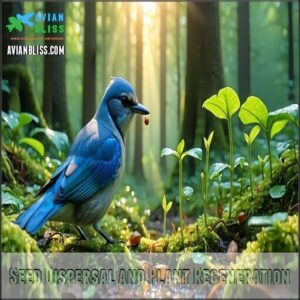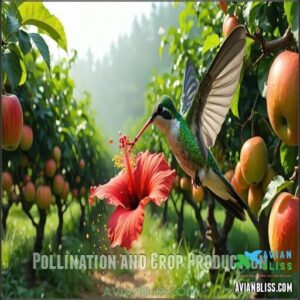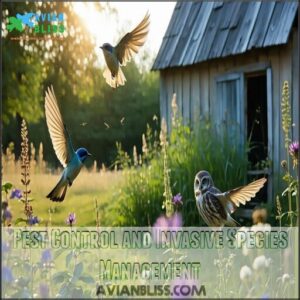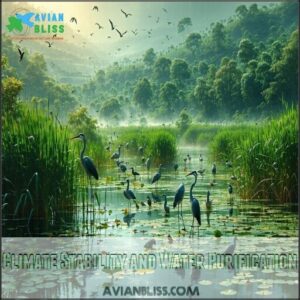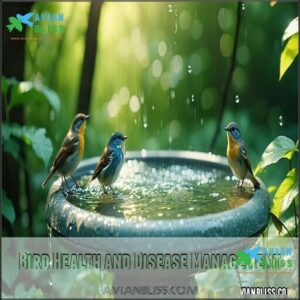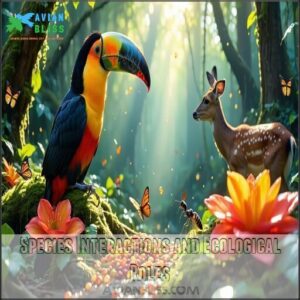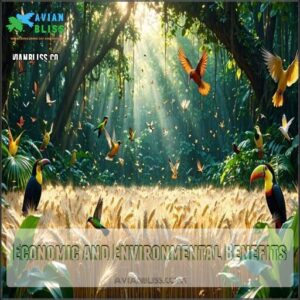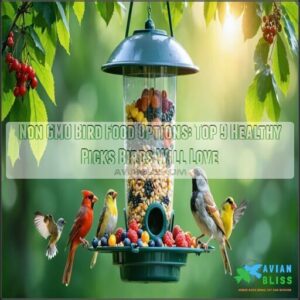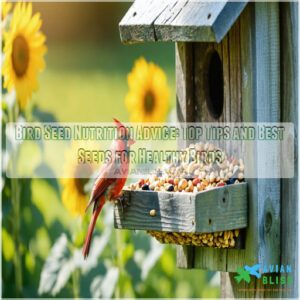This site is supported by our readers. We may earn a commission, at no cost to you, if you purchase through links.
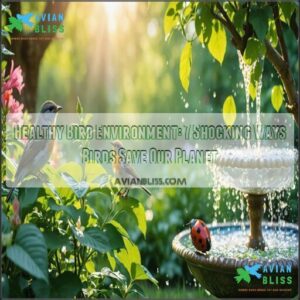
You’ve got to think like a bird!
Provide fresh water with birdbaths or small ponds—clean water means happy birds.
Ditch pesticides; they harm birds and disrupt the natural pest control they offer.
Native plants are like a buffet for birds, offering food and shelter while saving you time on upkeep.
Urban spaces can feel like home by adding trees, shrubs, and flowers that birds love.
Simple changes help birds thrive while balancing the local ecosystem.
Think about it: a little effort creates a refuge that benefits everyone, birds included, by providing a healthy bird environment with native plants.
Table Of Contents
- Key Takeaways
- Bird Habitat Conservation
- Ecosystem Services Provided
- Bird Health and Disease Management
- Species Interactions and Ecological Roles
- Economic and Environmental Benefits
- Frequently Asked Questions (FAQs)
- Are birds a good indicator of environmental health?
- How do birds contribute to the environment?
- What do birds need to survive?
- Why are birds important in urban environments?
- How do birds improve our quality of life?
- How do birds benefit humans?
- What is the best environment for birds?
- How to create a bird friendly habitat?
- How to keep birds healthy?
- What are the living conditions for birds?
- Conclusion
Key Takeaways
- You’ll create a thriving bird sanctuary by providing fresh water, planting native species, and eliminating pesticides—these simple changes support birds while balancing your local ecosystem.
- Your yard becomes part of the conservation solution when you reduce lawn space and add natural cover like brush piles, which helps maintain biodiversity and creates essential habitat connectivity.
- You’re supporting nature’s workforce when you welcome birds—they provide free ecosystem services including pest control, pollination, seed dispersal, and nutrient cycling worth billions.
- You’ll recognize healthy birds by monitoring for signs of stress or illness like feather abnormalities, appetite loss, and behavioral changes—clean habitats and fresh food sources help prevent disease transmission.
Bird Habitat Conservation
You’ll directly help birds thrive by creating habitats with native plants and protecting wetlands in your community.
Your efforts to reduce lawn space and add natural cover like brush piles won’t just support local bird populations but also enhance the overall biodiversity that keeps our planet healthy, and by doing so, you’ll be contributing to a healthier environment by preserving wetlands.
Protecting Wetlands and Forests
Did you know wetlands store 50 times more carbon than rainforests? These vital ecosystems, along with forests, form the backbone of bird habitat conservation.
They’re natural flood defenders too, providing $23 billion in annual protection for vulnerable communities. You can support wetland conservation by advocating for protection acts and joining restoration projects.
These efforts create habitat connectivity that birds depend on for survival. One can find resources for essential restoration products online.
Forest restoration boosts watershed carbon storage by 500%, while riparian buffers improve water quality for both birds and fish. By preserving these natural sanctuaries, you’re not just helping birds—you’re securing our planet’s future.
Creating Urban Bird Refuges
Beyond forests, our urban environments can become essential sanctuaries for our feathered friends.
You can create city sanctuaries right in your neighborhood, providing important stopover points for birds traveling through concrete landscapes.
Urban bird refuges offer three essential benefits:
- Safe havens for exhausted migratory birds crossing metropolitan areas
- Nesting opportunities in balconies, green roofs, and community gardens
- Habitat connectivity that prevents isolation and maintains genetic diversity.
Community involvement in refuge design makes these bird-friendly landscapes possible.
Even small spaces can form a connected network of bird habitats.
Your birdfriendly garden creates a safe environment where birds can thrive despite urbanization.
These birds often display behavioral urban adaptations to survive.
Incorporating Native Plants and Trees
Native plants transform your yard into a thriving bird sanctuary. They’re nature’s perfect buffet, providing seasonal food availability and nesting materials birds instinctively recognize.
Your local biodiversity gets a boost as native vegetation supports the insect populations birds depend on. The habitat restoration costs? Much lower than maintaining exotic plants, as natives require less water and care.
When selecting tree species, consider their impact: evergreens offer winter shelter while berry-producers supply food. Consider bird-friendly native trees for ideal results.
Plant in groups for maximum effect. This birdfriendly garden approach creates essential bird habitats that support conservation efforts without breaking the bank, providing a perfect winter shelter.
Reducing Lawn and Planting Natives
While native trees provide vertical habitat, your lawn offers another opportunity.
Shrinking your turf and planting natives creates instant bird habitats with remarkable benefits.
You’ll save water, reduce maintenance, and watch biodiversity increase as local birds find food and shelter.
Even small native patches improve habitat connectivity between larger green spaces.
Your yard becomes part of the environmental health solution—one native plant at a time, contributing to bird conservation.
Bird conservation starts right under your feet!
Ecosystem Services Provided
You’ll be amazed at how birds quietly work behind the scenes, providing essential services from seed dispersal to pest control that keep our ecosystems functioning.
Without their constant work pollinating plants, purifying water, and maintaining climate stability, our planet would be a much less habitable place, and this is due to their role in seed dispersal.
Seed Dispersal and Plant Regeneration
Birds serve as nature’s essential gardeners, transporting seeds across vast distances.
I’ll create a concise, engaging blockquote that captures the essence of birds as seed transporters in the same tone as the original paragraph:
Birds: Nature’s master gardeners, planting tomorrow’s forests with every flight.
When you watch birds eat berries, you’re witnessing the first step in plant regeneration.
These bird-dispersed seeds often germinate better after passing through avian digestive systems.
Here’s how birds support plant growth:
- They spread native plants to new areas, increasing plant diversity
- Their droppings create perfect natural fertilizer for seedlings
- They connect isolated habitats through seed dispersal mechanisms
- They support fungal network support by dispersing spores
- They maintain habitat connectivity across fragmented landscapes
Without these winged cleanup crews, many plant species couldn’t reproduce or colonize new territories, making birds vital partners in ecosystem health.
Some species, like the Woodhouse’s scrub-jay, exhibit food caching techniques to aid in winter survival, demonstrating their role in ecosystem health.
Pollination and Crop Production
Imagine this: your coffee, chocolate, and even the fruits in your kitchen owe a thanks to bird pollinators. These hard-working birds provide an invisible service – pollination – that supports one-third of global food production.
Without them, crop yields could drop by 5-8%, adding pressure to food security. Their work guarantees bigger, tastier fruits, boosting sustainable agriculture while enriching your meals.
In fact, 75% of crops that produce fruits and seeds depend on pollination. It’s not just nectar they’re after; it’s part of a broader system of ecosystem services, including seed dispersal. Bird pollinators don’t just help plants grow – they help economies thrive.
Pest Control and Invasive Species Management
While pollinating crops, birds also become pest control superheroes.
Their natural pest control tactics? Spot-on.
- Barn Swallows munch on mosquitoes, reducing bites and pest populations.
- Owls handle rodents, helping farmers avoid chemical solutions.
- Native restoration encourages their return, balancing invasive species and habitat competition.
- Birds reduce disease spread by eating harmful insects—simple, effective, and harmonious pest control delivered daily, winged-style!
Climate Stability and Water Purification
Protecting ecosystems isn’t just about reducing pests—it’s about creating the balance needed for everything to thrive, including water and climate.
Birds play a quiet yet powerful role in safeguarding ecological balance through their influence on habitat health.
- Carbon sequestration: Birds support habitats that store carbon, aiding climate stability.
- Nutrient cycling: Their droppings enrich soils, fueling plant growth.
- Wetland ecosystems: These bird-friendly areas filter water naturally.
- Water purification: Healthy bird populations mean cleaner, thriving environments.
When birds prosper, the planet’s delicate ecosystem resilience stays intact.
Bird Health and Disease Management
You can help prevent diseases in birds by keeping their habitats clean and providing them with fresh food and water.
Recognizing signs of illness or stress guarantees they stay healthy and thrive in their environment.
Maintaining Clean Habitats and Reducing Disease Transmission
Keeping bird habitats clean is essential for disease prevention and bird health.
Regular waste removal, water purity checks, and proper bird sanitation create a safer environment. Think of it as housekeeping for nature’s tenants—clean bird cages and excellent bird hygiene help control parasites and pathogens.
Follow strict routines to maintain natural immunity. Here’s a simple guide:
| Task | Frequency | Benefits |
|---|---|---|
| Waste Removal | Daily | Fewer pests and parasites |
| Water Changes | Twice daily | Improved water purity |
| Cage Cleaning | Weekly | Better bird sanitation |
| Surface Disinfect | Weekly | Blocks pathogen spread |
| Habitat Check | Monthly | Guarantees disease prevention |
Providing Natural Food Sources and Clean Water
A healthy bird diet starts with native plantings that provide seeds, berries, and insects. Prioritize fresh bird food over processed options for better bird nutrition.
Make certain clean water is always available by maintaining proper water source hygiene. Reduce contaminants by cleaning feeders regularly and focusing on natural diets.
You can find diverse native seed options for your local bird population. Make certain clean water is always available by maintaining proper water source hygiene. Reduce contaminants by cleaning feeders regularly and focusing on natural diets.
- Keep water fresh and uncontaminated.
- Use seasonal plants for diverse food options.
- Maintain bird feeder hygiene to avoid disease.
- Promote natural diets for year-round health.
Recognizing Signs of Illness and Stress in Birds
Feather abnormalities, appetite loss, and behavioral changes can show stress or illness in birds.
Watch for odd droppings, vocalization changes, or mobility issues like lethargy or drooping wings—they’re red flags for bird health.
Recognizing avian influenza symptoms is essential for early intervention.
Spot problems early to help your feathered buddy bounce back.
| Symptom | Possible Cause | What to Do | When to Call a Vet |
|---|---|---|---|
| Feather puffiness | Stress or chill | Warm, safe space | Persistent puffiness |
| Appetite loss | Illness or stress | Offer favorite food | 24+ hours of no eating |
| Vocal change | Pain or discomfort | Observe surroundings | Strange sounds persist |
| Lethargy | Low energy, illness | Keep calm and assess | Immediate if severe fatigue |
To address bird health issues effectively, it is crucial to monitor for signs of illness or stress, including appetite loss and vocal changes, and take prompt action as indicated in the table.
Creating Stress-Free Environments for Birds
Nothing keeps birds happier than reducing stress in their daily lives.
Create a thriving safe habitat by making small adjustments:
- Opt for spacious enclosures to boost comfort.
- Include enrichment activities like perches or mirrors.
- Provide full-spectrum lighting to support natural bird behavior.
- Avoid noise and sudden changes to reduce bird stress.
- Offer diverse, balanced nutrition for peak health.
These steps guarantee stress reduction and brighter bird behavior.
Species Interactions and Ecological Roles
You mightn’t realize it, but birds play vital roles in keeping ecosystems healthy. From controlling pests to pollinating plants, their interactions with other species help maintain balance in nature.
Birds as Natural Pest Controllers and Pollinators
Birds play a superhero role in keeping ecosystems balanced.
Their pest control saves crops by chomping on insects, reducing the need for harmful chemical pesticides.
Pollination is another gem—think hummingbirds buzzing from flower to flower, ensuring fruit and seed growth.
They also contribute to forest and plant diversity through seed dispersal.
Here’s how they work their magic:
Pest Control
Pollination
Seed Dispersal
Woodpeckers and Cavity-Nesting Species Interactions
Woodpeckers are nature’s architects, shaping ecosystems with their cavity creation.
Their role as ecosystem engineers enhances forest biodiversity by increasing snag importance.
These master drummers also aid cavity-nesting birds and reduce nesting competition, ensuring bird health thrives.
Their species interactions keep forests balanced, benefiting birds and other wildlife through these natural habitat adaptations, and they act as indicator species, reflecting habitat quality.
Vultures and Carrion Decomposition
Vultures, often called nature’s cleanup crew, play an unsung yet essential role in maintaining ecosystem cleanliness.
By swiftly handling carrion, these scavengers prevent harmful diseases like anthrax from spreading. Their carcass removal services speed up decomposition, improving sanitation and stopping rot from impacting other wildlife and humans.
However, vulture decline has serious consequences—carcasses linger longer, creating environmental imbalances and fostering disease. Imagine an ecosystem without their sanitation services—it would be chaos.
Vultures may not win beauty contests, but their scavenger roles make them indispensable for disease prevention and keeping ecosystems healthy, clean, and resilient. They’re true environmental superheroes!
Birds as Environmental Indicators and Ecological Engineers
While vultures clean our landscapes, other birds serve as nature’s warning system.
You’ll find these feathered environmental indicators reveal ecosystem health through their presence or absence.
Birds engineer our world in remarkable ways:
- They signal pollution and habitat quality changes
- They modify landscapes by creating nesting cavities
- They transport nutrients between ecosystems
- They enable plant regeneration through seed dispersal
- They maintain species balance in food webs
Watch closely—a thriving bird community means you’re living in a healthier environment.
Economic and Environmental Benefits
You’ll be amazed how birds boost our economy while healing our planet, from saving farmers millions in pest control costs to generating billions through ecotourism.
When you support healthy bird environments, you’re investing in nature’s most efficient workers who provide free services like seed dispersal, pollination, and nutrient cycling that would cost trillions to replace.
Guano Deposits and Nutrient Cycling
Beyond their ecological roles, birds are nature’s fertilizer factories.
Your garden’s best friend might be bird droppings. Bird guano deposits pack a powerful punch of nitrogen, phosphorus, and potassium that enrich soils worldwide.
In Arctic ecosystems, tiny Dovekies transport an astounding 3,500 tons of nutrients annually from ocean to land. This nutrient transport creates verdant oases where muskox populations thrive at ten times normal density.
Throughout history, guano’s value as fertilizer was so great that nations went to war over these deposits—nature’s original treasure.
Bird-Based Pest Control and Cost Savings
Through their remarkable pest control services, birds save farmers thousands in pesticide costs while boosting crop yields.
They’re nature’s most efficient pest managers.
- Falcon relocations to vineyards reduce crop damage by 68%, saving $234-$326 per hectare
- Insectivorous birds attracted by native hedgerows provide benefits without increasing pest bird damage
- Installing owl boxes creates natural rodent control in agricultural settings
- Birds reduced caterpillar densities in broccoli fields, increasing plant growth
- Sustainable agriculture practices that include avian pest control cut chemical dependency
This approach highlights the economic and environmental benefits of using birds for pest control, showcasing their value in agricultural settings.
Ecotourism and Birdwatching Economic Benefits
Your binoculars’ focus on birds actually generates $90 billion in labor income and supports 1.4 million jobs.
Birdwatching transforms conservation into economic opportunity without harming natural habitats.
When you spot birds, you’re spotting local economic growth too.
| Region | Economic Impact | Community Benefit |
|---|---|---|
| Nationwide | $90B labor income | 1.4M jobs created |
| Texas | $1.28B in spending | Local business growth |
| Per capita | 3.9× recreation value | 3× social benefit |
| Your community | Sustainable tourism | Conservation funding |
Restoration and Conservation Efforts for Healthy Bird Environments
While birdwatching creates economic opportunities, restoring healthy bird environments delivers profound benefits beyond tourism dollars.
You’ll boost habitat connectivity when you support restoration projects that help birds thrive and enhance climate resilience. These efforts protect genetic diversity and strengthen ecosystem health through thoughtful conservation.
Your involvement makes a difference through:
- Planting native species in your yard
- Volunteering for local habitat restoration
- Supporting policy advocacy for bird-friendly legislation.
Together, we’re building environmental resilience one restored habitat at a time.
Frequently Asked Questions (FAQs)
Are birds a good indicator of environmental health?
Yes, birds serve as excellent environmental indicators.
Their sensitivity to habitat changes, pollution, and food availability means you’ll notice declining bird populations before other environmental issues become obvious.
They’re like nature’s early warning system, and this role makes them a crucial part of understanding our ecosystem’s health.
How do birds contribute to the environment?
By jove, birds contribute to your environment in numerous ways!
They disperse seeds, control pests, pollinate plants, and enrich soil with nutrients.
They’re also excellent indicators of ecosystem health through their presence and behavior.
What do birds need to survive?
Birds need clean water, proper food, safe shelter, adequate space to move, and appropriate environmental conditions. They’ll thrive with natural light, social interaction, and protection from predators and extreme weather.
Why are birds important in urban environments?
Our feathered friends transform urban spaces into thriving ecosystems.
They’re also nature’s indicators of environmental health while providing joyful sights and sounds.
You’ll benefit from their pest control, seed dispersal, and pollination services.
How do birds improve our quality of life?
Your daily life gains richness when birds sing nearby, control pests in your garden, disperse seeds for new plants, and create moments of wonder.
You’ll enjoy cleaner air and reduced stress just watching them.
How do birds benefit humans?
Americans spend over $41 billion on birdwatching annually.
You’ll enjoy cleaner air and fewer pests when birds visit your yard.
They’ll also help pollinate plants, spread seeds, and simply brighten your day with their songs.
What is the best environment for birds?
The ideal environment for birds includes native plants, clean water, natural food sources, and adequate shelter.
You’ll attract more species by reducing lawn size and adding brush piles for cover and nesting opportunities.
How to create a bird friendly habitat?
Plant native vegetation for food and shelter, provide fresh water sources, and leave brush piles for nesting materials.
You’ll create a safe haven that attracts local birds and supports their natural behaviors.
How to keep birds healthy?
You’ll be shocked how simple bird health is!
Provide clean water daily, offer diverse natural foods, maintain clean feeders,
create stress-free environments with shelter, and watch for behavior changes that might indicate illness, which can be a key factor in maintaining overall bird health.
What are the living conditions for birds?
Birds need clean water, diverse food sources, shelter from predators, and enough space to fly and socialize.
You’ll see healthier birds when their environment mimics natural habitats with native plants nearby, which can be considered a complete concept for their well-being.
Conclusion
Incredibly, birds do far more than sing pretty tunes—they’re literally saving our planet daily.
By creating a healthy bird environment in your yard, you’re not just helping feathered friends; you’re supporting nature’s cleanup crew, pest controllers, and plant propagators.
You’ll witness firsthand how these ecosystem engineers transform your space while contributing to global sustainability.
Your small actions—planting natives, providing water, and eliminating chemicals—create a powerful ripple effect that benefits all living things, and by doing so, you’re aiding in global sustainability.
- https://www.perkypet.com/articles/40-things-you-can-do-today-to-protect-bird-habitats?srsltid=AfmBOoriul_AOll0QyBnANQ7lVQWg7CYZuL-rZepZNjezotv9Tk0A0e3
- https://www.birdsgeorgia.org/uploads/1/1/2/7/112764233/birds_and_their_environment_student_guide.pdf
- https://www.birds.cornell.edu/home/seven-simple-actions-to-help-birds/
- https://www.audubon.org/news/6-unexpected-ways-birds-are-important-environment-and-people
- https://www.timesonline.com/story/lifestyle/pets/2014/12/03/how-to-create-healthy-safe/18486348007/
